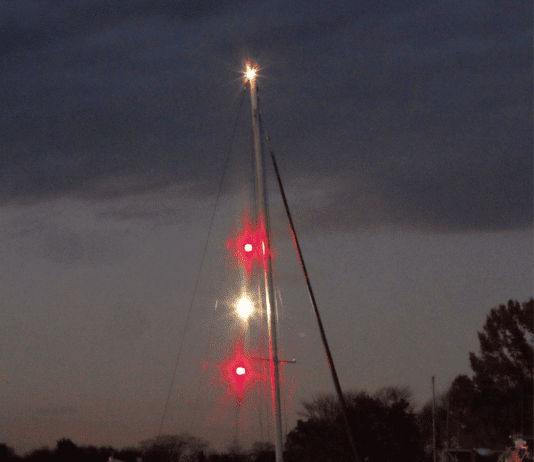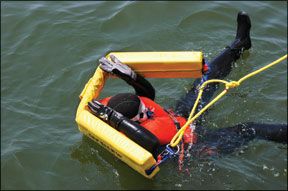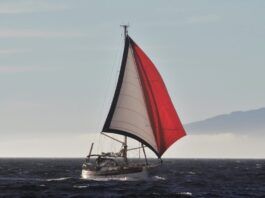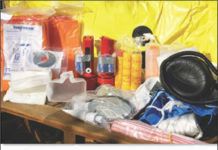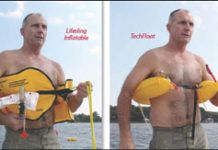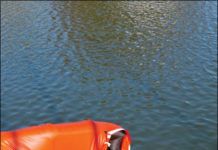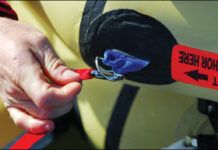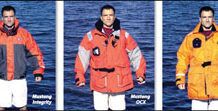Immersion Suit Test
Dominated by polyurethane-coated nylon immersion suits, the selection reflected a clear change in material preference among survival suit manufacturers. The tested immersion suits prices ranged from $260 to $700. Many of these companies also offer higher-grade, more expensive immersion suits that are aimed at commercial and search-and-rescue markets. Testers performed a thorough comparative analysis of the survival suits both in the water and on land. Details that were scrutinized included: weight, material, seam construction, zipper, reflective surface, boot and glove configuration, and air-purge valves. Testers were disappointed to find some of the suits used harnesses that could put sailors at risk.
Six-Man Life Raft Survival Equipment
For Practical Sailors six-man life raft test, the examiners looked at eight life rafts suitable for a cruising sailboat with far horizons: the DSB 6-ISAF, the Elliot 6-SOLAS, the Switlik MD-3, the Switlik SAR-6 MKII, the Viking Rescyou, the Viking Rescyou Pro, the Winslow Ocean Rescue, the Zodiac Class Ocean ISAF. A close look at the survival gear that each life raft manufacturer provides reveals that its generally left up to the owner to provide the gear that is more likely to expedite rescue (like a 406-EPIRB) or keep him alive (like a Katadyn hand-operated wate maker).
Throwable Man Overboard Aids
In an era when the ordinary life ring is being replaced by a wide range of improved rescue devices, Practical Sailor tested several rescue products that boast unique advantages as man-overboard flotation and retrieval aids. We gathered two throwable man-overboard devices that use automatically inflated chambers for flotation-the TechFloat from Survival Technologies and the Lifesling Inflatable from West Marine-and one made of expanded polyethylene foam-the Personal Retriever. Each comes with floating line; the bitter end of each is intended to stay in the hands of the rescuer or be tied to the vessel. Only the TechFloat is a certified U.S. Coast Guard (USCG) personal flotation device. We also tested a fourth throwable MOB aid-the Rescue Stick by Mustang Survival. Its a different animal than the other three, but shares many of the same features.
Six-Man Life Raft Test
How to choose a life raft? That is the question we answered in Part I of this series (“Choosing a Life raft,” March 2007). For Part II, we conducted a series of tests that mirrored those carried out by the U.S. Coast Guard and other certifying agencies. We asked manufacturers to send us six-man life rafts that they thought best suited a serious offshore sailor seeking a SOLAS life raft or its recreational equivalent. Six manufacturers responded to our request, sending a total of eight six-man life rafts: the 6-SOLAS from Elliot, the Switlik MD-3, the DSB ISAF, the Switlik SAR-6 MKII; the Viking RescYou (UKL), the Viking RescYou Pro (UKSL), the Winslow Ocean Rescue; and the Zodiac Class Ocean ISAF life raft. As it turned out, the life raft testers faced the very difficult task of distinguishing the best life rafts for cruising sailors among an outstanding field of entries.
Rhumb Lines: 04/07
At Practical Sailor, we approach every product review and test that we carry out with a high level of seriousness, and when it comes to safety gear, the level of responsibility is elevated a notch further. These are devices where the smallest detail can have grave consequences.
Life Raft Test Part I: Choosing a Life Raft
Our life raft test is carried out against the backdrop of relatively new marine safety standards. New criteria for life rafts for recreational boats have been established by the International Sailing Federation (ISAF) and the International Standards Organization (IS0). The Practical Sailor comparison features an in-depth look at eight life rafts: the DSB ISAF raft, Elliot SOLAS raft, Switlik MD-3 raft, Switlik SAR-MKII raft, Viking RescYou (UKL), Viking RescYou Pro (USKL), Winslow Ocean Rescue, and the Zodiac Class Ocean ISAF raft. As far as standards go, SOLAS is clearly top notch.
USCG: Time to Ditch Those 121.5/243 MHz EPIRBs
The U.S. Coast Guard instituted a ban on the use of both 121.5 and 243 MHz Emergency Position Indicating Radio Beacons (EPIRBs) on Jan. 1, 2007, in preparation for Feb. 1, 2009, when satellite processing of distress signals from all 121.5/243 MHz beacons will terminate.
Float Coats Tested
Cool weather sailors looking for something that keeps them warm as well as keeps them afloat if they fall overboard may want to consider a float coat. We look at six coats that cover the range of options available waist-length coats, mid-length coats, inflatable jackets, and foam-filled jackets. For the budget-minded sailor, the Stearns Powerboat Jacket offers good value, while the Mustang Integrity rated as our Best Choice. Two other jackets, the auto-inflating Float Tech jacket and the Stearns Windward Jacket earn our recommendation.
Review of Life jackets for Dogs
Dogs are natural swimmers, but they do get tired. Our testers examine a wide range of life jackets designed to keep dogs afloat, including one device that automatically inflates. The seven products in our test of dog life jackets include products from Ruff Wear, the OTE (Kent/Boaters World), Plastimo, West Marine, Critters Inflatable, MTI, and NRS.
No Need To Travel Light
We review two new abandon-ship bags from ACR.































